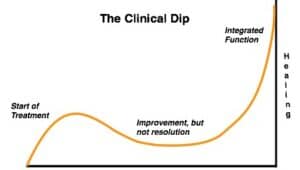When Things Get Tough
Whenever I need a little perspective, I’ll often look to find a good book and a good one I did find. It’s a little gem by Seth Godin called “The Dip”. It doesn’t break a 100 pages, but it’s message (as is often the case with Godin’s books) is an insightful one. He describes a couple of different curves that we will experience when embarking on something new: the Dip, the Cul-de-Sac and the Cliff. (For the purpose of this blog entry, we’ll just focus on the Dip).
He recounts that whenever we embark on a new endeavor such as learning a new skill, building a business, embarking on a new career, that we’ll hit roadblocks. His graph is a good one. It shows how we’ll often get some great results early on, but as time/effort continue on we enter into the zone called “the Dip”.

It’s a place where most people quit. It’s where the hard work with little reward comes about. As Godin describes it:
“The Dip is the long slog between starting and mastery. A long slog that’s actually a shortcut, because it gets you where you want to go faster than any other path.” (p. 17)
And it’s in these dips that we often quit. We give up because it seems that the light at the end of the proverbial tunnel is dim and flickering. It’s in those moments where we need to draw on some much needed motivation. We need to move through the discomfort and temporary pain. But it’s that short term pain that clouds our belief in our ability to achieve our vision. As he puts it:
Short term pain has more impact on most people than long-term benefits do, which is why it’s so important for you to amplify the long-term benefits of not quitting. You need to remind yourself of life at the other end of the Dip because it’s easier to overcome the pain of yet another unsuccessful cold call if the reality of a successful sales career is more concrete. (p. 53-54)
This excerpt is an important one as it calls us to return to our initial vision. It means we need to revisit the Destination Postcard that we initially created (mentally or visually) when excitement and motivation were in ample supply.
Patterns of Healing
 As I’ve been reflecting on those this concept of the Dip, I’ve thought about my patients; about the journey that they experience as they move from pain to healing. And it’s interesting the various patterns of healing that can emerge.
As I’ve been reflecting on those this concept of the Dip, I’ve thought about my patients; about the journey that they experience as they move from pain to healing. And it’s interesting the various patterns of healing that can emerge.
Sometimes the journey is a slow gradual improvement; other times it almost feels spontaneous. There is also a consistent pattern where there’s a small, but significant change and improvement and then there’s a dip-sometimes short and other times long. As therapists we know that there will be a period of time that is required for bodily healing.
But what happens when that dip seems to start to drag out longer than we thought? It’s at those points that these dips can frustrate both patient and therapist. Depending on how long the dip goes on, it can cause us to question our approach (rightfully so!) and refer to another practitioner, but other times it requires a certain steadfastness to the process.
Recently in a staff meeting we were talking about this very topic… how do you know when you’ve stalled out in the process? And that’s the question I’d like to pose here.
- What criteria do you use in identifying whether the Dip is just a “dip” or when another course of action is required?
- What strategies have you successfully used to re-engage the patient during this stage?
As always I look forward to your thoughts.

